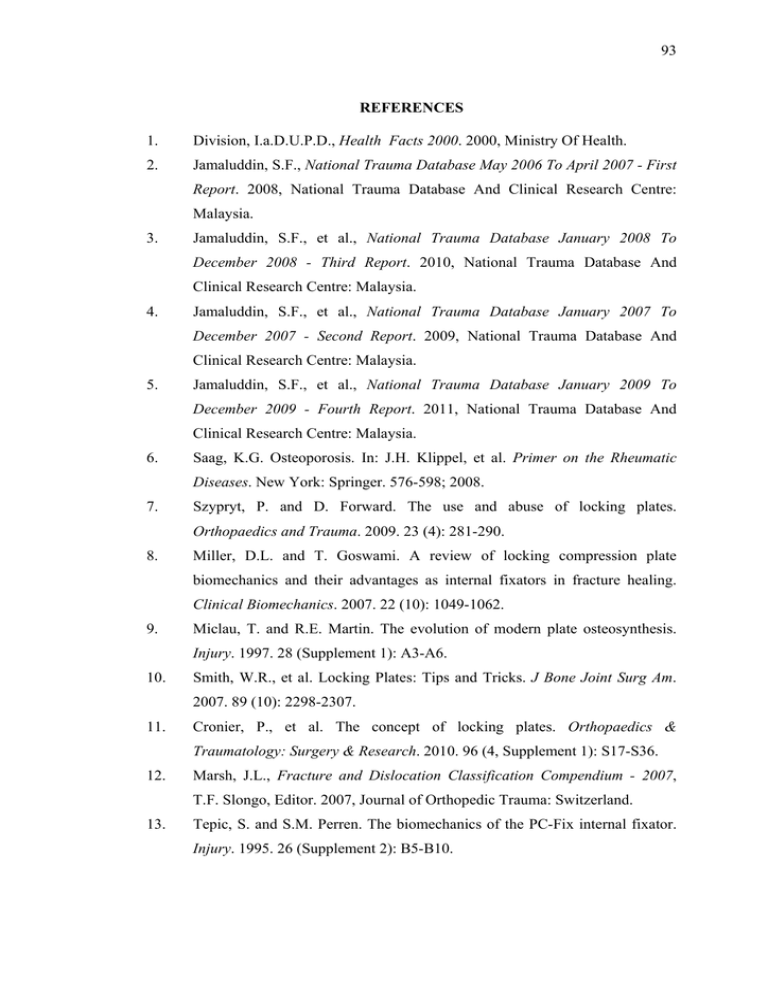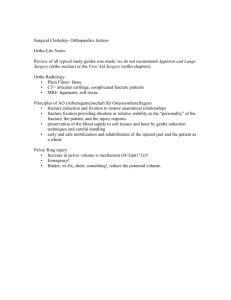
93
REFERENCES
1.
Division, I.a.D.U.P.D., Health Facts 2000. 2000, Ministry Of Health.
2.
Jamaluddin, S.F., National Trauma Database May 2006 To April 2007 - First
Report. 2008, National Trauma Database And Clinical Research Centre:
Malaysia.
3.
Jamaluddin, S.F., et al., National Trauma Database January 2008 To
December 2008 - Third Report. 2010, National Trauma Database And
Clinical Research Centre: Malaysia.
4.
Jamaluddin, S.F., et al., National Trauma Database January 2007 To
December 2007 - Second Report. 2009, National Trauma Database And
Clinical Research Centre: Malaysia.
5.
Jamaluddin, S.F., et al., National Trauma Database January 2009 To
December 2009 - Fourth Report. 2011, National Trauma Database And
Clinical Research Centre: Malaysia.
6.
Saag, K.G. Osteoporosis. In: J.H. Klippel, et al. Primer on the Rheumatic
Diseases. New York: Springer. 576-598; 2008.
7.
Szypryt, P. and D. Forward. The use and abuse of locking plates.
Orthopaedics and Trauma. 2009. 23 (4): 281-290.
8.
Miller, D.L. and T. Goswami. A review of locking compression plate
biomechanics and their advantages as internal fixators in fracture healing.
Clinical Biomechanics. 2007. 22 (10): 1049-1062.
9.
Miclau, T. and R.E. Martin. The evolution of modern plate osteosynthesis.
Injury. 1997. 28 (Supplement 1): A3-A6.
10.
Smith, W.R., et al. Locking Plates: Tips and Tricks. J Bone Joint Surg Am.
2007. 89 (10): 2298-2307.
11.
Cronier, P., et al. The concept of locking plates. Orthopaedics &
Traumatology: Surgery & Research. 2010. 96 (4, Supplement 1): S17-S36.
12.
Marsh, J.L., Fracture and Dislocation Classification Compendium - 2007,
T.F. Slongo, Editor. 2007, Journal of Orthopedic Trauma: Switzerland.
13.
Tepic, S. and S.M. Perren. The biomechanics of the PC-Fix internal fixator.
Injury. 1995. 26 (Supplement 2): B5-B10.
94
14.
Patel, V.A. Biomechanical Evaluation of Locked and Non-locked Constructs
Under Axial And Torsion Loading. M.Sc. Thesis. Wright State University;
2008.
15.
Tortora, G.J. and B. Derrickson. Principles of Anatomy And Physiology.
United States of America: John Wiley & Sons, Inc. 2009.
16.
Bartel, D.L., D.T. Davy, and T.M. Keaveny. Orthopaedic Biomechanics:
Mechanics and Design in Musculoskeletal Systems. New Jersey: Pearson
Prentice Hall. 2006.
17.
Netter, F.H. and J.T. Hansen. Atlas of human anatomy: Icon Learning
Systems. 2003.
18.
Bangash, M.Y.H., F.N. Bangash, and T. Bangash. Trauma - an engineering
analysis: with medical case studies investigation: Springer. 2007.
19.
Schmitt, K.U., et al. Trauma biomechanics: accidental injury in traffic and
sports: Springer. 2007.
20.
Hosalkar, H.S., et al. Skeletal Trauma and Common Orthopedic Problems. In:
J.S. Khurana. Bone Pathology. Humana Press. 159-177; 2009.
21.
Tencer, A.F. and K.D. Johnson. Biomechanics in orthopedic trauma: bone
fracture and fixation. United Kingdom: Martin Dunitz. 1994.
22.
Cordey, J., R. Grütter, and R. Johner. The mechanical strength of bones in
torsion application to human tibiae. Injury. 2000. 31 (Supplement 3): 68-71.
23.
Franco, V., et al. Open Wedge High Tibial Osteotomy. Techniques in Knee
Surgery. 2002. 1 (1): 43-53.
24.
Parkinson, R.W. and V. Bhalaik. (iii) The valgus and varus knee. Current
Orthopaedics. 2001. 15 (6): 413-422.
25.
Macnicol, M.F. Realignment osteotomy for knee deformity in childhood. The
Knee. 2002. 9 (2): 113-120.
26.
Franco, V., et al. (ii) Osteotomy for osteoarthritis of the knee. Current
Orthopaedics. 2005. 19 (6): 415-427.
27.
Rüedi, T.P., R.E. Buckley, and C.G. Moran. AO principles of fracture
management: Thieme. 2007.
28.
Ip, D. Principles of Fracture Fixation. In. Orthopedic Traumatology — A
Resident’s Guide. Heidelberg: Springer Berlin 85-132; 2006.
29.
Tan, S.L.E. and Z.J. Balogh. Indications and limitations of locked plating.
Injury. 2009. 40 (7): 683-691.
95
30.
Duckworth, T. Lecture notes on orthopaedics and fractures: Blackwell
Science. 1995.
31.
Pallister, I. and A. Iorwerth. Indirect reduction using a simple quadrilateral
frame in the application of distal tibial LCP: technical tips. Injury. 2005. 36
(9): 1138-1142.
32.
Faschingbauer, M., et al. Treatment of Distal Lower Leg Fractures: Results
with Fixed-Angle Plate Osteosynthesis. European Journal of Trauma and
Emergency Surgery. 2009. 35 (6): 513-519.
33.
Metcalfe, A.J., M. Saleh, and L. Yang. Asymmetrical fracture fixation:
stability of oblique fractures is influenced by orientation. Clinical
Biomechanics. 2005. 20 (1): 91-96.
34.
Lerner, A., et al. Complications encountered while using thin-wire-hybridexternal fixation modular frames for fracture fixation: A retrospective clinical
analysis and possible support for "Damage Control Orthopaedic Surgery".
Injury. 2005. 36 (5): 590-598.
35.
Lee, T., N.M. Blitz, and S.M. Rush. Percutaneous Contoured Locking Plate
Fixation of the Pilon Fracture: Surgical Technique. The Journal of Foot and
Ankle Surgery. 47 (6): 598-602.
36.
Hans, K.U., P. Philippe, and S.B. David. Internal plate fixation of fractures:
short history and recent developments. J Orthop Sci. 2006. 11 (2): 118-26.
37.
Perren, S.M. Evolution Of The Internal Fixation Of Long Bone Fractures:
The Scientific Basis Of Biological Internal Fixation: Choosing A New
Balance Between Stability And Biology. J Bone Joint Surg Br. 2002. 84-B
(8): 1093-1110.
38.
Stoffel, K.K. Modern Concepts in Plate Osteosynthesis. PhD. Thesis.
University of Western Australia; 2007.
39.
Perren, S.M., et al. The limited contact dynamic compression plate (LCDCP). Archives of Orthopaedic and Trauma Surgery. 1990. 109 (6): 304-310.
40.
Miranda, M.A. Locking plate technology and its role in osteoporotic
fractures. Injury. 2007. 38 (3, Supplement 1): 35-39.
41.
Perren, S.M., et al. A dynamic compression plate. Acta Orthop Scand Suppl.
1969. 125: 31-41.
96
42.
Schütz, M. and N.P. Südkamp. Revolution in plate osteosynthesis: new
internal fixator systems. Journal of Orthopaedic Science. 2003. 8 (2): 252258.
43.
Perren, S.M. Evolution and rationale of locked internal fixator technology:
Introductory remarks. Injury. 2001. 32 (Supplement 2): 3-9.
44.
Frigg, R. Locking Compression Plate (LCP). An osteosynthesis plate based
on the Dynamic Compression Plate and the Point Contact Fixator (PC-Fix).
Injury. 2001. 32 (Supplement 2): 63-66.
45.
Smith, T.O., et al. The clinical and radiological outcomes of the LISS plate
for distal femoral fractures: A systematic review. Injury. 2009. 40 (10): 10491063.
46.
Schandelmaier, P., et al. Distal femoral fractures and LISS stabilization.
Injury. 2001. 32 (Supplement 3): 55-63.
47.
Kumar, V., et al. Less Invasive Stabilization System for the Management of
Periprosthetic Femoral Fractures Around Hip Arthroplasty. The Journal of
Arthroplasty. 2008. 23 (3): 446-450.
48.
Mushtaq, A., et al. Distal Tibial Fracture Fixation with Locking Compression
Plate (LCP) Using the Minimally Invasive Percutaneous Osteosynthesis
(MIPO) Technique. European Journal of Trauma and Emergency Surgery.
2009. 35 (2): 159-164.
49.
S. Inc. Synthes Instrument and implant approved by the AO foundation. USA.
2003.
50.
S. Inc. Large Fragment LCP Instrument and Implant set. USA. 2003.
51.
Ip, D. Normal and Abnormal Bone Healing. In. Orthopedic Traumatology —
A Resident’s Guide. Heidelberg: Springer Berlin 45-84; 2006.
52.
Dimitriou, R., E. Tsiridis, and P.V. Giannoudis. Current concepts of
molecular aspects of bone healing. Injury. 2005. 36 (12): 1392-1404.
53.
Doblaré, M., J.M. García, and M.J. Gómez. Modelling bone tissue fracture
and healing: a review. Engineering Fracture Mechanics. 2004. 71 (13-14):
1809-1840.
54.
Calmar, E.A. and R.J. Vinci. The anatomy and physiology of bone fracture
and healing. Clinical Pediatric Emergency Medicine. 2002. 3 (2): 85-93.
55.
Hounsfield, G.N. Computerized transverse axial scanning (tomography). 1.
Description of system. Br J Radiol. 1973. 46 (552): 1016-22.
97
56.
Nelissen, E., E. van Langelaan, and R. Nelissen. Stability of medial opening
wedge high tibial osteotomy: a failure analysis. International Orthopaedics.
2010. 34 (2): 217-223.
57.
Gaasbeek, R., et al. Correction accuracy and collateral laxity in open versus
closed wedge high tibial osteotomy. A one-year randomised controlled study.
International Orthopaedics. 2010. 34 (2): 201-207.
58.
Chae, D.J., et al. Early complications of medial opening wedge high tibial
osteotomy using autologous tricortical iliac bone graft and T-plate fixation.
The Knee. 2011. 18 (4): 278-284.
59.
Hankemeier, S., et al. Accuracy of high tibial osteotomy: comparison
between open- and closed-wedge technique. Knee Surgery, Sports
Traumatology, Arthroscopy. 2010. 18 (10): 1328-1333.
60.
Stoffel, K., G. Stachowiak, and M. Kuster. Open wedge high tibial
osteotomy: biomechanical investigation of the modified Arthrex Osteotomy
Plate (Puddu Plate) and the TomoFix Plate. Clinical Biomechanics. 2004. 19
(9): 944-950.
61.
Krishna, K.R., I. Sridhar, and D.N. Ghista. Analysis of the helical plate for
bone fracture fixation. Injury. 2008. 39 (12): 1421-1436.
62.
Genta, G. The Finite Element Method. In: G. Genta. Vibration Dynamics and
Control. US: Springer. 363-400; 2009.
63.
Duda, G.N., et al. Mechanical boundary conditions of fracture healing:
borderline indications in the treatment of unreamed tibial nailing. Journal of
Biomechanics. 2001. 34 (5): 639-650.
64.
Benli, S., et al. Evaluation of bone plate with low-stiffness material in terms
of stress distribution. Journal of Biomechanics. 2008. 41 (15): 3229-3235.
65.
Blecha, L.D., et al. How plate positioning impacts the biomechanics of the
open wedge tibial osteotomy; A finite element analysis. Computer Methods in
Biomechanics and Biomedical Engineering. 2005. 8 (5): 307 - 313.
66.
Chen, G., et al. PREDICTING THE FATIGUE LIFE OF INTERNAL
FRACTURE FIXATION PLATES. Journal of Biomechanics. 2008. 41
(Supplement 1): S495-S495.
67.
Bresina, S.J. and S. Tepic. Finite element analysis (FEA) for the Point contact
fixator screw drive, plate design, overcuts. Injury. 1995. 26 (Supplement 2):
B20-B23.
98
68.
Zhim, F., et al. Biomechanical stability of high tibial opening wedge
osteotomy: Internal fixation versus external fixation. Clinical Biomechanics.
2005. 20 (8): 871-876.
69.
Spahn, G. and R. Wittig. Primary stability of various implants in tibial
opening wedge osteotomy: a biomechanical study. Journal of Orthopaedic
Science. 2002. 7 (6): 683-687.
70.
Fan, Y., et al. Biomechanical and histological evaluation of the application of
biodegradable poly-l-lactic cushion to the plate internal fixation for bone
fracture healing. Clinical Biomechanics. 2008. 23 (Supplement 1): S7-S16.
71.
Peleg, E., et al. A short plate compression screw with diagonal bolts: A
biomechanical evaluation performed experimentally and by numerical
computation. Clinical Biomechanics. 2006. 21 (9): 963-968.
72.
Kim, S.-H., S.-H. Chang, and H.-J. Jung. The finite element analysis of a
fractured tibia applied by composite bone plates considering contact
conditions and time-varying properties of curing tissues. Composite
Structures. 2010. 92 (9): 2109-2118.
73.
KazImoglu, C., et al. Which is the best fixation method for lateral cortex
disruption in the medial open wedge high tibial osteotomy? A biomechanical
study. The Knee. 2008. 15 (4): 305-308.
74.
Sonoda, N., et al. Biomechanical analysis for stress fractures of the anterior
middle third of the tibia in athletes: nonlinear analysis using a threedimensional finite element method. Journal of Orthopaedic Science. 2003. 8
(4): 505-513.
75.
Cordey, J., M. Borgeaud, and S.M. Perren. Force transfer between the plate
and the bone: relative importance of the bending stiffness of the screws and
the friction between plate and bone. Injury. 2000. 31 (Supplement 3): 21-28.
76.
Jacobi, M., P. Wahl, and R. Jakob. Avoiding intraoperative complications in
open-wedge high tibial valgus osteotomy: technical advancement. Knee
Surgery, Sports Traumatology, Arthroscopy. 2010. 18 (2): 200-203.
77.
Niemeyer, P. and N.P. Sudkamp. Principles and clinical application of the
locking compression plate (LCP). Acta Chir Orthop Traumatol Cech. 2006.
73 (4): 221-8.
99
78.
Gong, H., Y.B. Fan, and M. Zhang. Computational Simulation for
Osteoporosis at the Basic Multicellular Unit Level. In: Y. Peng and X. Weng.
7th Asian-Pacific Conference on Medical and Biological Engineering.
Heidelberg: Springer-Berlin 182-185; 2008.
79.
Meneghini, R., et al. Stem diameter and rotational stability in revision total
hip arthroplasty: a biomechanical analysis. Journal of Orthopaedic Surgery
and Research. 2006. 1 (1): 1-7.
80.
Augat, P., et al. Shear movement at the fracture site delays healing in a
diaphyseal fracture model. Journal of Orthopaedic Research. 2003. 21 (6):
1011-1017.
81.
Will, R., et al. Locking plates have increased torsional stiffness compared to
standard plates in a segmental defect model of clavicle fracture. Archives of
Orthopaedic and Trauma Surgery. 2010: 1-7.
82.
Cheng, H.-Y.K., et al. Biomechanical evaluation of the modified doubleplating fixation for the distal radius fracture. Clinical Biomechanics. 2007. 22
(5): 510-517.
83.
Aro, H.T. and E.Y. Chao. Bone-healing patterns affected by loading, fracture
fragment stability, fracture type, and fracture site compression. Clin Orthop
Relat Res. 1993 (293): 8-17.
84.
Gorsse, S. and D.B. Miracle. Mechanical properties of Ti-6Al-4V/TiB
composites with randomly oriented and aligned TiB reinforcements. Acta
Materialia. 2003. 51 (9): 2427-2442.
85.
Taylor, W.R., et al. Tibio-femoral loading during human gait and stair
climbing. Journal of Orthopaedic Research. 2004. 22 (3): 625-632.
86.
Kim, S.-H., S.-H. Chang, and H.-J. Jung. The finite element analysis of a
fractured tibia applied by composite bone plates considering contact
conditions and time-varying properties of curing tissues. Composite
Structures. In Press, Corrected Proof.
87.
Bachus, K.N., M.T. Rondina, and D.T. Hutchinson. The effects of drilling
force on cortical temperatures and their duration: an in vitro study. Medical
Engineering & Physics. 2000. 22 (10): 685-691.
88.
Matthews, L.S. and C. Hirsch. Temperatures Measured in Human Cortical
Bone when Drilling. The Journal of Bone and Joint Surgery. 1972. 54 (2):
297-308.
100
89.
Rosson, J., et al. Bone weakness after the removal of plates and screws.
Cortical atrophy or screw holes? J Bone Joint Surg Br. 1991. 73-B (2): 283286.
90.
Fouad, H. Assessment of function-graded materials as fracture fixation boneplates under combined loading conditions using finite element modelling.
Medical Engineering & Physics. 2011. 33 (4): 456-463.
91.
Stoffel, K., et al. Biomechanical testing of the LCP - how can stability in
locked internal fixators be controlled? Injury. 2003. 34 (Supplement 2): 1119.
92.
Cordey, J., S.M. Perren, and S.G. Steinemann. Stress protection due to plates:
myth or reality? A parametric analysis made using the composite beam
theory. Injury. 2000. 31 (Supplement 3): 1-13.
93.
Duda, G.N., et al. Mechanical conditions in the internal stabilization of
proximal tibial defects. Clinical Biomechanics. 2002. 17 (1): 64-72.
94.
Cheal, E.J., et al. Stress analysis of a simplified compression plate fixation
system for fractured bones. Computers & Structures. 1983. 17 (5-6): 845855.
95.
Ehlinger, M., P. Adam, and F. Bonnomet. Minimally invasive locking screw
plate fixation of non-articular proximal and distal tibia fractures.
Orthopaedics & Traumatology: Surgery & Research. 2010. 96 (7): 800-809.
96.
Ellis, T., C.A. Bourgeault, and R.F. Kyle. Screw Position Affects Dynamic
Compression Plate Strain in an In Vitro Fracture Model. Journal of
Orthopaedic Trauma. 2001. 15 (5): 333-337.
97.
Bone, L.B., et al. Displaced isolated fractures of the tibial shaft treated with
either a cast or intramedullary nailing. An outcome analysis of matched pairs
of patients. J Bone Joint Surg Am. 1997. 79 (9): 1336-41.
98.
Merchant, T.C. and F.R. Dietz. Long-term follow-up after fractures of the
tibial and fibular shafts. J Bone Joint Surg Am. 1989. 71 (4): 599-606.
99.
Ahmad, M., et al. Biomechanical testing of the locking compression plate:
When does the distance between bone and implant significantly reduce
construct stability? Injury. 2007. 38 (3): 358-364.
100.
Gautier, E., S.M. Perren, and J. Cordey. Effect of plate position relative to
bending direction on the rigidity of a plate osteosynthesis. A theoretical
analysis. Injury. 2000. 31 (Supplement 3): 14-20.
101
101.
Fouad, H. Effects of the bone-plate material and the presence of a gap
between the fractured bone and plate on the predicted stresses at the fractured
bone. Medical Engineering & Physics. 32 (7): 783-789.
102.
Seebeck, J., et al. Effect of cortical thickness and cancellous bone density on
the holding strength of internal fixator screws. Journal of Orthopaedic
Research. 2004. 22 (6): 1237-1242.
103.
Seebeck, J., et al. Mechanical behavior of screws in normal and osteoporotic
bone. Osteoporosis International. 2005. 16 (0): S107-S111.
104.
French, B. and P. Tornetta, 3rd. High-energy tibial shaft fractures. Orthop
Clin North Am. 2002. 33 (1): 211-30, ix.
105.
Egol, K.A., R. Dolan, and K.J. Koval. Functional outcome of surgery for
fractures of the ankle. A prospective, randomised comparison of management
in a cast or a functional brace. J Bone Joint Surg Br. 2000. 82 (2): 246-9.
106.
Boer, P.d. and R. Metcalfe. (iv) Pilon fractures of the tibia. Current
Orthopaedics. 2003. 17 (3): 190-199.
107.
Ronga, M., et al. Percutaneous Plating of Ankle Fractures. In: A. Saxena.
International Advances in Foot and Ankle Surgery. London: Springer. 163168; 2012.
108.
Clare, M.P. and R.W. Sanders. Percutaneous ORIF of Periarticular Distal
Tibia Fractures. In: G.R. Scuderi and A.J. Tria. Minimally Invasive Surgery in
Orthopedics. New York: Springer. 515-522; 2010.
109.
Ronga, M., et al. Percutaneous Osteosynthesis of Distal Tibial Fractures
Using Locking Plates Minimally Invasive Surgery of the Foot and Ankle. In:
N. Maffulli and M. Easley. London: Springer. 357-361; 2011.
110.
Kim, H.-J., S.-H. Kim, and S.-H. Chang. Bio-mechanical analysis of a
fractured tibia with composite bone plates according to the diaphyseal
oblique fracture angle. Composites Part B: Engineering. 2011. 42 (4): 666674.
111.
Kim, S.-H., S.-H. Chang, and D.-S. Son. Finite element analysis of the effect
of bending stiffness and contact condition of composite bone plates with
simple rectangular cross-section on the bio-mechanical behaviour of fractured
long bones. Composites Part B: Engineering. 2011. 42 (6): 1731-1738.
112.
Anglen, J.O. Early Outcome of Hybrid External Fixation for Fracture of the
Distal Tibia. Journal of Orthopaedic Trauma. 1999. 13 (2): 92-97.
102
113.
Grose, A., et al. Open Reduction and Internal Fixation of Tibial Pilon
Fractures Using a Lateral Approach. Journal of Orthopaedic Trauma. 2007.
21 (8): 530-537
114.
Chowdhry, M. and K. Porter. The pilon fracture. Trauma. 2010. 12 (2): 89103.
115.
Kanchanomai, C., V. Phiphobmongkol, and P. Muanjan. Fatigue failure of an
orthopedic implant - A locking compression plate. Engineering Failure
Analysis. 2008. 15 (5): 521-530.
116.
Kao, F.C., et al. Treatment of distal tibial fractures by minimally invasive
percutaneous plate osteosynthesis of three different plates: Results and costeffectiveness analysis. Formosan Journal of Musculoskeletal Disorders.
2010. 1 (1): 35-40.
117.
Krackhardt, T., et al. Fractures of the distal tibia treated with closed reduction
and minimally invasive plating. Archives of Orthopaedic and Trauma
Surgery. 2005. 125 (2): 87-94.





